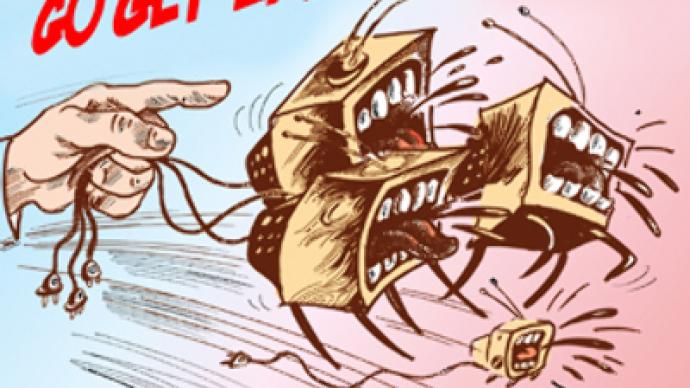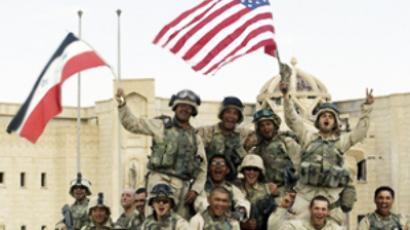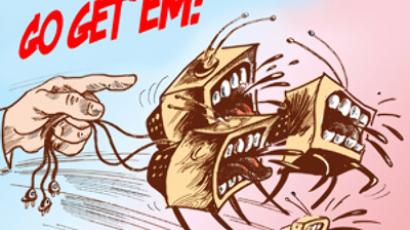Spin-a-war. The War on Terror as a spin of imagination. Part 1. Inventions

A bit of literature to start with
In one of the most famous novels by Graham Greene, ‘Our Man in Havana,’ a man yields to a Secret Intelligence Service’s recruitment pitch out of a desperate need for extra money to maintain high living standards for his pretty adolescent daughter. The man starts inventing agents and sub-agents to justify the money he gets, but suddenly real people around him are involved in his game, including his friends, and then they start dying for real. The protagonist is a middle-aged Briton who lives in pre-Fidel Havana.
In 2001, another man repeated this fate with a twist: he took a real enemy – international and militant but lacking any actual military force – reinvented it as a ‘network supported by certain countries’, and declared a war. This leap of his imagination, supported by the imaginations or cold-blooded interests of those in his immediate circle of associates, caused several real shooting wars and thousands of totally unnecessary casualties.
The biggest problem with this second protagonist was that he, at the moment when his mind was in its most creative mode, occupied the most powerful office on Earth – that of the President of the United States of America.
Generations of historians will busy themselves with defining the role George W. Bush played in the history of the U.S. and the world. One fact, though, will remain unchallenged by any of them: that the man invented the war on terrorism.
A bit of history to continue
For a historian, terrorism is nothing new. Definitions vary in wording every time a new wave of it starts in the world, but every one of them presumes that terrorism is an attempt to reach political or ideological ends through criminal means (murder, mass murder, hijacking, etc) in order to terrorize society into accepting a certain course of action or a certain idea.
Terrorism is always a militant action by armed criminals against unarmed civilians or against a public figure, guarded by armed bodyguards but denied the possibility to stay protected at all times and against all threats by the very essence of his/her public status. In fewer words, terrorism is always an attempt by a group of people to impose their own rules on society by force.
Prior to the Russian revolution, the best known revolutionaries were the terrorists, or ‘the bombists.’ Very few people knew of Lenin and the Bolsheviks before 1917. Everyone knew Prince Kropotkin, the members of ‘The People’s Freedom’ and later the Socialist Revolutionaries. The latter group evolved into a whole political party which had, like the IRA after it, a political wing and a combat (terrorist) wing.
They proclaimed Socialism as the objective of their struggle and made terrorism their means of choice: the idea was to kill as many officials of the Monarchic state as would be needed to make the people understand that the Romanov Monarchy ruled not by divine right, but by the submission of the people. The ultimate goal was to provoke the people into an uprising against the Monarchy and stand at the head of that uprising.
What the Socialist Revolutionaries failed to achieve by terror from1860-1914, the Bolsheviks achieved in one summer; the summer of 1917, by clever and well-addressed propaganda and by taking over the Soviets – the grassroots democratic institutions, naturally born all over the country during the February 1917 liberal-democratic revolution.
The ‘Red Terror’ of 1918–1920 that the Bolsheviks pursued when they were already firmly in control, was a government policy of suppression that was aimed at eliminating any tiny spec of opposition. It was bloody and ruthless – but it was terror, not terrorism, if you know what I mean.
As for the most active period for the terrorist wing of the Socialist Revolutionaries, the first decade of the 20th Century, their multi-level clandestine operation met with an equally multi-layered and complex response from the ‘Okhrana,’ or ‘Protective Police Unit,’ a police Special Branch of sorts. The terrorists were the primary targets, because their own main target was the person of the Russian Emperor and members of the Imperial family.
The Okhrana was a mixture of a police agency and intelligence service. It worked both in Russia and abroad, with small but effective networks in Europe and in the United States, especially on the American West Coast. California in those days was the preferred rest and recreation destination for Russian ‘bombists.’ In San Francisco they lived openly, without fear of prosecution or persecution, they gathered and argued about politics and they published their own periodical publications and books in Russian.
In California, Russian terrorists planned their operations. The Okhrana had imposed on itself a permanent ban on any forceful actions in America. The rules were strict: no arrests, no shoot-outs. The objective was to penetrate the revolutionary circles and find out their immediate and long-term plans. It was done, and most effectively, by the means of good old ‘Humint’ – human intelligence: agents or moles planted within the terrorists’ organizations.
The same was done in Europe, where the conditions were not as favorable for the terrorists and local police forces often helped their Russian colleagues (Europe still had most of its Monarchies in place, and Monarchies tend to think alike about regicide, even if they are enemies or rivals).
As a result, all the activities by the terrorists were under close scrutiny of the Okhrana, and even their loudest success, the murder of Interior Minister Stolypin in 1912, is tainted by the fact that the assassin was simultaneously a member of a terrorist combat group and an Okhrana mole.
Russian historians still argue today about the reasons for the killing of Stolypin. They agree that the only party that benefited from it were the land-owning nobility and the court, because Stolypin’s unfinished land reform was rapidly Westernizing the Russian agricultural sector, making a farmer out of the Russian peasant, at the time free more in name than in fact.
A bit of geography and ethnography for dessert
The long historical discourse above shows one thing clearly: terrorism is best fought via police and intelligence methods. More than that: it never occurred to anyone in Tsarist Russia to fight terrorism with military force. Or to blame the U.S. government of the time for support of terrorism.
Let us remember that, in the first decade of the 20th Century, Russia, even weakened by the war with Japan and the unsuccessful revolution of 1905-07, still was a superpower rivaling Britain, France and Germany, while America was taking its first steps in the international political arena.
Let us remember as well that Britain and Germany were Monarchies and France, itself a republic, wasn’t trying to impose its democracy on fellow superpowers but, to the contrary, at every opportunity emphasized its deep respect of European Monarchic values. If, in that context, Russia had raised the question of the U.S. supporting and harboring terrorists with known regicidal intentions, it could have led to consequences well beyond simple diplomatic reprimands.
But that never happened. First of all because all European governments understood: terrorists may occasionally use a country or a city as their base, known or unknown to the local authorities, but it doesn’t mean that their cause is not alien to most of the people who give them shelter.
Saddam Hussein’s Iraq was not a very tolerant state and definitely not a democracy. But it didn’t share a cause with Al-Qaeda. And there is still no proof that any connection between them existed at all.
The Taliban in Afghanistan before the 2001 invasion harbored Al-Qaeda. But it also had no common cause with it before foreign soldiers arrived. The Taliban was not even as anti-American as some other regimes in the Middle East and Central Asia.
What has the U.S.-led alliance achieved by the military operations in Iraq and Afghanistan? Regime change. In the both cases a regime was changed and replaced with chaos.
Has anybody caught Bin Laden? Have the two wars weakened Al-Qaeda and other terrorist groups around the world?
No, to both questions. And that should be the end of the war on terror. But somehow there is a feeling that it is not…
Evgeny Belenkiy, RT.














